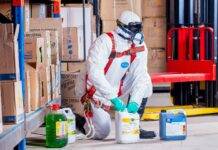
What is the Number 1 Golden Rule in COSHH?
What is the Number 1 Golden Rule in COSHH? : Workplaces across industries are governed by stringent safety regulations, none more crucial than the Control of Substances Hazardous to Health (COSHH). This essential framework ensures the safe handling, usage, and management of hazardous substances, guaranteeing the well-being of employees and the environment.
Introduction to COSHH
COSHH, an acronym for Control of Substances Hazardous to Health, constitutes a set of regulations designed to safeguard individuals against the risks posed by hazardous substances in the workplace. From chemicals to biological agents, these substances demand careful management to prevent harm.
Understanding the Number 1 Golden Rule
The cornerstone of COSHH compliance revolves around the golden rule: “Prevention is better than cure.” This principle underscores the proactive approach of minimizing exposure to hazardous substances rather than mitigating their effects after exposure has occurred.
Risk Assessment and Control Measures
A fundamental aspect of COSHH adherence involves conducting comprehensive risk assessments. By identifying potential hazards and implementing robust control measures, organizations mitigate risks effectively.
Training and Education
Education and training play pivotal roles in ensuring COSHH compliance. Empowering employees with knowledge about hazardous substances and safe handling practices is paramount for a safer work environment.
Regular Review and Monitoring
Constant evaluation and monitoring are essential for sustaining COSHH compliance. Regular checks and updates ensure that control measures remain effective and aligned with evolving workplace dynamics.
Legal Compliance and Responsibilities
Employers bear the responsibility of ensuring COSHH compliance. Understanding legal obligations and consequences of non-compliance is vital to prioritize safety.
Benefits of Adhering to COSHH
Adhering to COSHH guidelines not only enhances workplace safety but also contributes to the overall health and well-being of employees, fostering a more productive work environment.
Common Misconceptions about COSHH
Misconceptions surrounding COSHH often lead to confusion. Addressing these myths helps in clarifying misconceptions and promoting accurate understanding.
Examples of COSHH Violations
Real-life scenarios of COSHH violations highlight the repercussions faced by organizations failing to comply, emphasizing the importance of strict adherence.
Implementing Effective COSHH Strategies
Adopting best practices and creating a robust management plan facilitates effective COSHH implementation, ensuring safety measures are in place.
Technology and Innovations in COSHH Compliance
Technological advancements aid in enhancing COSHH compliance, providing innovative tools and software for better management of hazardous substances.
Case Studies of Successful COSHH Implementation
Examining successful implementation stories offers valuable insights into effective COSHH practices and their impact on workplace safety.
Global Perspectives on COSHH
Contrasting global approaches to COSHH regulation allows for a broader understanding of different standards and implementations across regions.
Future Trends and Developments in COSHH
Predicting future trends and developments in COSHH sheds light on potential advancements and evolving standards, shaping the future of workplace safety.
Conclusion
In conclusion, the number 1 golden rule in COSHH, “Prevention is better than cure,” encapsulates the essence of proactively managing hazardous substances in the workplace. Adhering to COSHH guidelines not only ensures compliance but also fosters a culture of safety and well-being.
Why COSHH is Essential for Workplace Safety
FAQs
- What are the key components of a COSHH management plan? A COSHH management plan typically includes a thorough inventory of hazardous substances, detailed risk assessments, measures for controlling exposure, employee training, regular monitoring, emergency procedures, and clear communication of safety protocols.
- How often should COSHH risk assessments be conducted? COSHH risk assessments should be conducted regularly and whenever there are changes in substances, work processes, or equipment that could impact employee exposure to hazardous materials. Generally, they should be reviewed at least annually or more frequently if circumstances change.
- What are the consequences of non-compliance with COSHH regulations? Non-compliance with COSHH regulations can result in serious consequences, including legal penalties, fines, damaged reputation, increased health risks for employees, potential accidents or injuries, and overall decreased workplace safety.
- Are there specific industries more prone to COSHH violations? Industries dealing with chemicals, pharmaceuticals, manufacturing, construction, healthcare, and laboratories are often more exposed to hazardous substances and therefore more prone to COSHH violations if proper precautions and safety measures are not in place.
- How do technological advancements aid in COSHH compliance? Technological advancements offer tools such as specialized software for substance inventory management, real-time monitoring devices, personal protective equipment innovations, and online training modules, all of which enhance monitoring, control, and education in ensuring COSHH compliance.
























